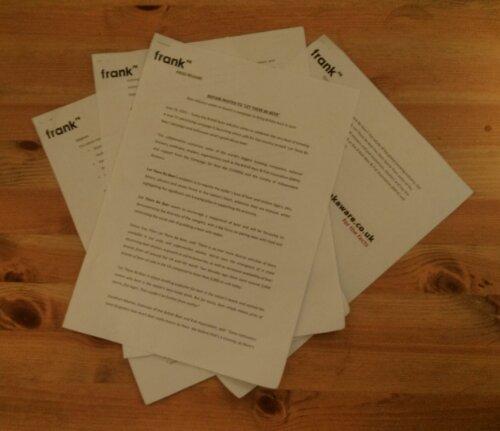I have a disclaimer to post: a shadowy organisation gave me £500 to be at the European Beer Bloggers Conference. I am their shill! But, who are they? What are they up to? Do I now preach to the church of craft Bud Light?
They are “@LetThereBeBeer” to the public – so far just a Twitter account (that says “Must be 18+ to follow. Please only share with those of legal drinking age“), and a Facebook page I can’t see because I have no Facebook account. (US marketing/alcohol laws supposedly.) Under the hood they’re Frank. A PR firm – hired by the biggest brands in the beer world, they’re mercenary marketeers cashed up by the multi-nationals to sell an IDEA. And that idea is beer. How the idea will be formed exactly, how it will come across, it still to be found out. Who they are is summed up in the press release sitting in front of me:
“Who is behind Let There Be Beer? The whole of the global brewing industry, but to get a bit more specific Let There Be Beer has been borne from some of the world’s biggest brewers, UK brewers and pub businesses, retailer and organisations such as the British Beer & Pub Association (BBPA) and Campaign for Real Ale (CAMRA).“
– Britain Invited To “Let There Be Beer” – Press Release
(Full PR only seems to be online at heineken.co.uk.)
The claimed mission is “instilling a passion for beer in the nation’s hearts” to remind them “why beer is the nations best-loved drink” because for many “beer simply means pints of warm, flat lager“. The BBPA is involved (mixed feelings about them), apparently CAMRA “support” them (haven’t yet seen what that entails) as do SIBA. They’re bankrolled by (at least) AB InBev, Heineken, Molson Coors, Miller Coors – all of whom have CEOs “available for comment.” The press release is effusive in the support of beer, exclaims its importance, and throws some stats at us – I’m not qualified to dissect it, I suggest you read the press release for yourself (the paper copy I have has a little more detail, and less errors – but I’m not about to transcribe it – turns out AbInBev have a much better version of the PR online). I’ll keep an eye out for opinions from some of the UK’s proper beer folk, which I don’t really expect to see much of until the curtains are opened on the campaign for real. Dave of Hardknott brewery is the only proper beer type to have said anything about it as far as I have seen.[1] He is uncertain about the thing since the message isn’t yet clear – and leaning to cynical (unsurprisingly), his post is cheekily tagged “Silly PR campaigns”. As per a comment from Tandleman a lot of this seems to be very last minute, much like the crazy day-before-the-event EBBC scholarship competition I managed to win.
Why are they even involved in a conference for beer bloggers? I’m no marketer – but my guess is they need to find ideas, they need to mine the people who love beer for the edges they can explore to build the beer market. It is early days yet. The young woman from Frank who I met at EBBC seemed very earnest about the project and was pleasant to speak to and seemed receptive about thoughts on beer and its place alongside food. (Terribly, her name slips my mind, as usual.) Still at the beer discovery phase herself, learning: yes, this beer stuff isn’t actually too bad, is it? (So I gathered.) Beer can be outstanding – so long as you know what to look for – and what to do with it when you’ve found it. I suppose that’ll be the hurdle they need to leap: how to get these ideas across to the public? “There is more to beer, and it deserves a place in your life.”
What should we all think of this? Us “beer bloggers“… are we a rich seam, a natural resource ripe for exploiting? A mine of information? In a way, I hope so. If, with big marketing money, they can have some success at opening up new views on beer that would hopefully work for us all. Grow the beer market out into new areas, most will probably go dull-macro, but they’re new beer drinkers – there’s now more of a hope they can “upgrade” to better, more local, and more my kind of beer. Could this not be a good thing for ALL beer lovers, and the industry as a whole from the big boys down to the start-ups?
I really don’t know enough to make that call. I’m not a natural optimist, I’m a cynical bastard at the best of times. I don’t trust corporates – anyone with “shareholders” is automatically suspect. This campaign, however it pans out, will be all about building the market for the multinationals – who’re seeing a decline in beer sales while the “craft” side of the industry is growing. We can just hope it works in our favour as well – that good beer is a focus and becomes a bigger slice of the pie that we all can enjoy. Drinkers like myself as well as the many good breweries, brewers, and other beer trade people out there. Just don’t be fooled into thinking the CEOs and investors of the given companies actually give a stuff, at the end of the day this is all about just one thing: dollars in their pockets.
 As for the conference itself, my thoughts on that belong in a separate post which I shall try to find the time to create. I wasn’t originally going to the conference as I don’t consider myself a “beer blogger”, I’m just a chap who happens to blog about beer. That makes sense in my head at least. I’ll try to get around to explaining what I mean. I did have a great time, and it was a good event, and UTTERLY amazing value for £95 – I hope it is a worthwhile exercise for the good breweries & folk who put their time and money into it. I have Let There Be Beer to thank for being able to go… and I do & did thank them. But I won’t fawn, promote, or even be optimistic – I’ve never been comfortable about this sort of campaign in any industry. The tech scene is full of it, and this is why you’ll find most of us tech folk will be cynical and won’t trust you. (I used to be in InfoSec, can you tell?)
As for the conference itself, my thoughts on that belong in a separate post which I shall try to find the time to create. I wasn’t originally going to the conference as I don’t consider myself a “beer blogger”, I’m just a chap who happens to blog about beer. That makes sense in my head at least. I’ll try to get around to explaining what I mean. I did have a great time, and it was a good event, and UTTERLY amazing value for £95 – I hope it is a worthwhile exercise for the good breweries & folk who put their time and money into it. I have Let There Be Beer to thank for being able to go… and I do & did thank them. But I won’t fawn, promote, or even be optimistic – I’ve never been comfortable about this sort of campaign in any industry. The tech scene is full of it, and this is why you’ll find most of us tech folk will be cynical and won’t trust you. (I used to be in InfoSec, can you tell?)
In the meantime, certainly “let there be beer” – really good beer, and plenty of it. Cheers!
[1] Dave’s post somehow passed me by – I’ve been busy – I found it just now as one of just two hits for the quoted intro from the press release’s final “about” section: “Who is behind Let There Be Beer”. I see there is a video. I haven’t seen it, I don’t have the right plugin installed.


